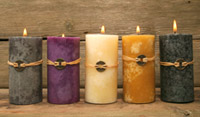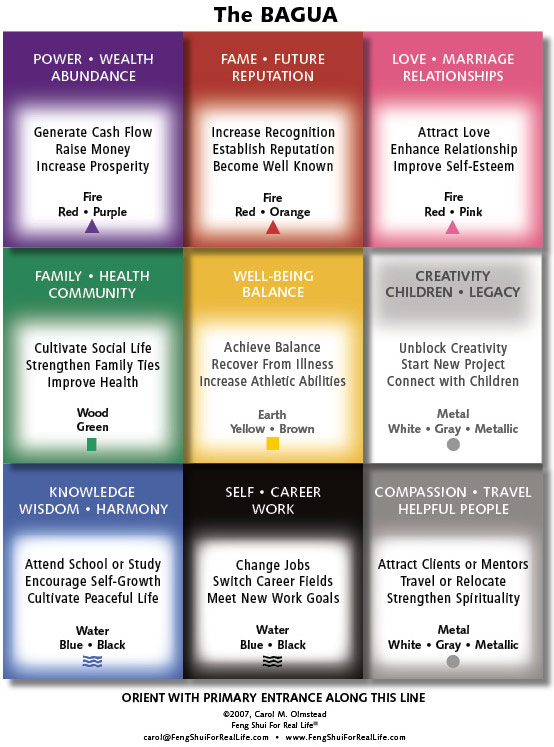basics
 Feng Shui is a system for arranging your surroundings in harmony and balance with the natural world around you. In Chinese, the words Feng Shui mean "wind and water." Feng Shui For Real Life is a contemporary, practical approach that allows you to use what you already have and what you want to acquire to bring good things into your life.
Feng Shui is a system for arranging your surroundings in harmony and balance with the natural world around you. In Chinese, the words Feng Shui mean "wind and water." Feng Shui For Real Life is a contemporary, practical approach that allows you to use what you already have and what you want to acquire to bring good things into your life.In our complex world, more people are turning to practical uses of Feng Shui to help them through chaotic times.
The Five Power Principles of Feng Shui
- Power Principle #1 -- Chi
- Chi is energy. It is the constantly moving and changing life force that we feel around us making us feel either good or bad in a certain location. Chi can accumulate in the objects around you. In your home or office, the chi will flow in through the door and out through the windows. The goal of Feng Shui improvements (or "cures") is to keep the chi flowing gently throughout your environment rather than running straight through it. Chi can have a negative effect on your surroundings when it gets stuck or blocked.
- Power Principle #2 - The Five Elements
- The Five Elements is the collective name used to describe the colors, shapes, and textures around you. The Elements are: Fire, Earth, Metal, Water, and Wood. Each Element is distinguished by a characteristic shape, colors, and set of attributes. Feng Shui improvements for homes and offices balance all of these Elements in your interior environment.
| ELEMENT | SHAPE | COLORS | ATTRIBUTES |
| Fire | Red, Orange, Purple | Passion, Emotion | |
| Earth | Brown, Yellow | Grounding, Stability | |
| Metal | White, Metallic | Strength, Independence | |
| Water | Black, Blue | Relaxation, Inspiration | |
| Wood | Green, Teal | Growth, Expansion |
- Power Principle #3 - The Bagua
- The Bagua is the chart used to map the areas of a home or office and determine where to locate the objects and colors that represent the Five Elements. The traditional bagua is an octagon (the word bagua means "8-sided" in Chinese). Modern approaches to Feng Shui use a grid-shaped chart to map nine areas of your life (see Bagua Map):
- Power/Wealth/Abundance
- Fame/Future/Reputation
- Love/Relationships/Marriage
- Creativity/Children/Legacy
- Compassion/Travel/Helpful People
- Self/Career/Work
- Knowledge/Wisdom/Harmony
- Family/Health/Community
- Well-Being/Balance
DOWNLOAD A BAGUA
Choose either a horizontal or a vertical bagua, depending on the shape of your house:
- Power Principle #4 - Yin and Yang
- According to the yin-yang theory, everything in the universe consists of two opposing, but interconnected, forces: yin, which is feminine, and yang, which is masculine. Yin qualities are female, soft, passive, nurturing, dark, while the yang qualities are male, hard, active, aggressive, bright. This Power Principle relates to balancing the opposites around you to achieve harmony, like soft and hard, cold and hot, dark and light, floral and geometric, straight and curvy.
- Power Principle #5 - Continuity and Connectedness
- This principle relates to the belief that the more your interior surroundings feel connected to the natural world outside, the more balanced you'll feel inside. Because every action has a reaction, we are influenced by everything around us and, in turn, we influence everything. In Feng Shui, we believe "you are what you see." That is, the colors, shapes, and images you use to decorate your surroundings will influence what you attract into your life.
